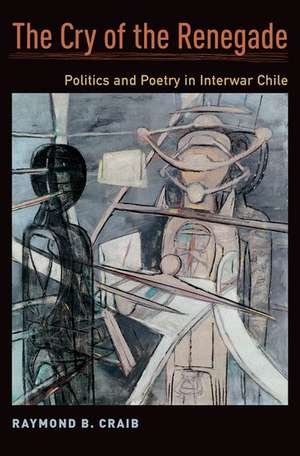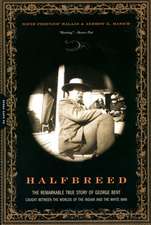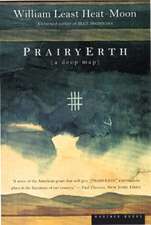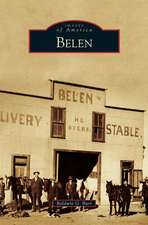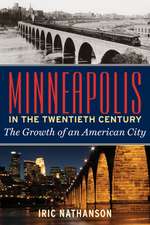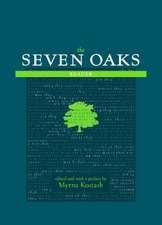The Cry of the Renegade: Politics and Poetry in Interwar Chile
Autor Raymond B. Craiben Limba Engleză Hardback – 15 sep 2016
| Toate formatele și edițiile | Preț | Express |
|---|---|---|
| Paperback (1) | 153.09 lei 11-16 zile | |
| Oxford University Press – 30 mai 2019 | 153.09 lei 11-16 zile | |
| Hardback (1) | 322.41 lei 32-37 zile | |
| Oxford University Press – 15 sep 2016 | 322.41 lei 32-37 zile |
Preț: 322.41 lei
Preț vechi: 367.01 lei
-12% Nou
Puncte Express: 484
Preț estimativ în valută:
61.70€ • 63.74$ • 51.32£
61.70€ • 63.74$ • 51.32£
Carte tipărită la comandă
Livrare economică 10-15 martie
Preluare comenzi: 021 569.72.76
Specificații
ISBN-13: 9780190241353
ISBN-10: 0190241357
Pagini: 288
Ilustrații: 51 illus.
Dimensiuni: 239 x 155 x 31 mm
Greutate: 0.54 kg
Editura: Oxford University Press
Colecția OUP USA
Locul publicării:New York, United States
ISBN-10: 0190241357
Pagini: 288
Ilustrații: 51 illus.
Dimensiuni: 239 x 155 x 31 mm
Greutate: 0.54 kg
Editura: Oxford University Press
Colecția OUP USA
Locul publicării:New York, United States
Recenzii
Raymond Craib's rendering is quite novel--and inspiring... [A]ll the book's assertions are supported by copious and carefully marshalled sources... [I]t is a book that should attract not only Chileans or followers of Chilean history, but anyone with any sensitivity towards human agency writ large.
His book will interest scholars working on twentieth-century Chile, anarchism in Latin America, and student movements in general... [A] compelling narrative... Craib's book provides a more humanized and quotidian account of real people struggling for their right to a just salary, education, free speech, and mobility within and among nation-states... [A] beautifully written story of the alliance among students and workers during the 1920s in Santiago... We need more books like this; books focused on real activists with multiple needs, desires, frustrations, and interests; stories anchored in the streets in which anarchists walked and marched, spaces that were contested, disputed, and challenged by insolent actions and subversive words
Craib succeeds in painting a vivid picture of the lived experience of these creators of Santiago's 'capacious left' in 1920. With 52 illustrations including photographs, detailed maps, and periodical reproductions, a narrative structure organizing each chapter around a different individual story, and an evocative, almost poetic narrative voice, the book can place the reader amid the blocks of anarchist Santiago, allowing him or her to imagine its shoemakers, printers, and students living, arguing, and agitating in the streets
Through a deep, moving, historically embedded homage to Chilean student, poet, and rebel Gómez Rojas, Craib illuminates an entire epoch of emancipatory fervor, circulating internationally but solidly rooted in the lived experience of Santiago. Very, very rarely is history so vivid, closely documented, passionate, and, above all, alive.
Craib uses the life and death of an anarchist poet, his friends and comrades, as a window on an era, a city, a country, and a movement. This is a luminous book, hard-hitting and incisive, but also eloquent and nuanced, at once an evocative account of everyday anarchism and a portrait of the 'capacious left' of the post-World War I years, when students and workers joined together to protest social injustice.
Approaching anarchism not so much as an ideology or a movement, but rather as a personal and collective disposition to what he terms 'insolence,' Raymond Craib explains brilliantly what drew people to anarchist ideas and forms of activism. A rich and compelling narrative history that marshals, effortlessly, economic, social, and political history and an impressive range of sources, The Cry of the Renegade sheds new light on a pivotal moment in Chile's modern history while making a major and highly original contribution to the comparative study of anarchism.
Raymond Craib's wise and informative book narrates the violence -- and the context of the violence -- of the third week of July 1920 in Santiago, Chile, which was marked by the imprisonment of a great many young anarchists, guilty of thinking ideas about a more just society. Among them was José Domingo Gómez Rojas, a 24-year-old poet who was tortured and died after weeks in prison. Gómez Rojas's spirit and the spirit of his poetry live on in Craib's The Cry of the Renegade. This book is a service to the history of Chile, to the history of Latin America, and to the history of the world.
The link Craib makes with the transnational aspect takes the book from the details of what was happening in Santiago in a particular moments in time and puts it in context, giving a sense and perspective to the decision making of the authorities and the discourses and speeches of those considered subversive.
Craib's rich and compelling stories and insights together stand as a significant contribution to what is a thin Chilean historiography on a period during which class conflict intensified, the old elite saw its commanding grip on politics slip away, and student groups, anarchists, and other emergent forces claimed spaces in the public sphere and on the streets ... [It] will appeal to scholars and students interested in politics, ideology, class conflict, labor, student organizations and mobilization, and nationalism. Craib's writing is lively and often poetic, tying together the life stories of the study's main actors, and the discourses, institutions, and events that shaped their world ... Provides us a deeper and more nuanced understanding of episodes with far-reaching implications in twentieth-century Chilean society, politics, and collective memory.
In his impassioned and deeply researched book, The Cry of the Renegade, Raymond B. Craib brings alive the roiling streets of Santiago in the interwar years. ... Craib tells a romantic story of martyrdom, while always being especially careful not to romanticize it, and of how a kind of radicalism of another era tried to face down a world looking far too much like our own ... without ever falling into the traps of presentism. ... At the same time, he provides a compelling and complex account of anarchism, which is far more attractive, far more radical, and far more open -- especially to other currents in the' capacious Left' -- than any presented by its current acolytes in geography.
His book will interest scholars working on twentieth-century Chile, anarchism in Latin America, and student movements in general... [A] compelling narrative... Craib's book provides a more humanized and quotidian account of real people struggling for their right to a just salary, education, free speech, and mobility within and among nation-states... [A] beautifully written story of the alliance among students and workers during the 1920s in Santiago... We need more books like this; books focused on real activists with multiple needs, desires, frustrations, and interests; stories anchored in the streets in which anarchists walked and marched, spaces that were contested, disputed, and challenged by insolent actions and subversive words
Craib succeeds in painting a vivid picture of the lived experience of these creators of Santiago's 'capacious left' in 1920. With 52 illustrations including photographs, detailed maps, and periodical reproductions, a narrative structure organizing each chapter around a different individual story, and an evocative, almost poetic narrative voice, the book can place the reader amid the blocks of anarchist Santiago, allowing him or her to imagine its shoemakers, printers, and students living, arguing, and agitating in the streets
Through a deep, moving, historically embedded homage to Chilean student, poet, and rebel Gómez Rojas, Craib illuminates an entire epoch of emancipatory fervor, circulating internationally but solidly rooted in the lived experience of Santiago. Very, very rarely is history so vivid, closely documented, passionate, and, above all, alive.
Craib uses the life and death of an anarchist poet, his friends and comrades, as a window on an era, a city, a country, and a movement. This is a luminous book, hard-hitting and incisive, but also eloquent and nuanced, at once an evocative account of everyday anarchism and a portrait of the 'capacious left' of the post-World War I years, when students and workers joined together to protest social injustice.
Approaching anarchism not so much as an ideology or a movement, but rather as a personal and collective disposition to what he terms 'insolence,' Raymond Craib explains brilliantly what drew people to anarchist ideas and forms of activism. A rich and compelling narrative history that marshals, effortlessly, economic, social, and political history and an impressive range of sources, The Cry of the Renegade sheds new light on a pivotal moment in Chile's modern history while making a major and highly original contribution to the comparative study of anarchism.
Raymond Craib's wise and informative book narrates the violence -- and the context of the violence -- of the third week of July 1920 in Santiago, Chile, which was marked by the imprisonment of a great many young anarchists, guilty of thinking ideas about a more just society. Among them was José Domingo Gómez Rojas, a 24-year-old poet who was tortured and died after weeks in prison. Gómez Rojas's spirit and the spirit of his poetry live on in Craib's The Cry of the Renegade. This book is a service to the history of Chile, to the history of Latin America, and to the history of the world.
The link Craib makes with the transnational aspect takes the book from the details of what was happening in Santiago in a particular moments in time and puts it in context, giving a sense and perspective to the decision making of the authorities and the discourses and speeches of those considered subversive.
Craib's rich and compelling stories and insights together stand as a significant contribution to what is a thin Chilean historiography on a period during which class conflict intensified, the old elite saw its commanding grip on politics slip away, and student groups, anarchists, and other emergent forces claimed spaces in the public sphere and on the streets ... [It] will appeal to scholars and students interested in politics, ideology, class conflict, labor, student organizations and mobilization, and nationalism. Craib's writing is lively and often poetic, tying together the life stories of the study's main actors, and the discourses, institutions, and events that shaped their world ... Provides us a deeper and more nuanced understanding of episodes with far-reaching implications in twentieth-century Chilean society, politics, and collective memory.
In his impassioned and deeply researched book, The Cry of the Renegade, Raymond B. Craib brings alive the roiling streets of Santiago in the interwar years. ... Craib tells a romantic story of martyrdom, while always being especially careful not to romanticize it, and of how a kind of radicalism of another era tried to face down a world looking far too much like our own ... without ever falling into the traps of presentism. ... At the same time, he provides a compelling and complex account of anarchism, which is far more attractive, far more radical, and far more open -- especially to other currents in the' capacious Left' -- than any presented by its current acolytes in geography.
Notă biografică
Raymond B. Craib is Associate Professor of History at Cornell University. He is the author of Cartographic Mexico: A History of State Fixations and Fugitive Landscapes.
